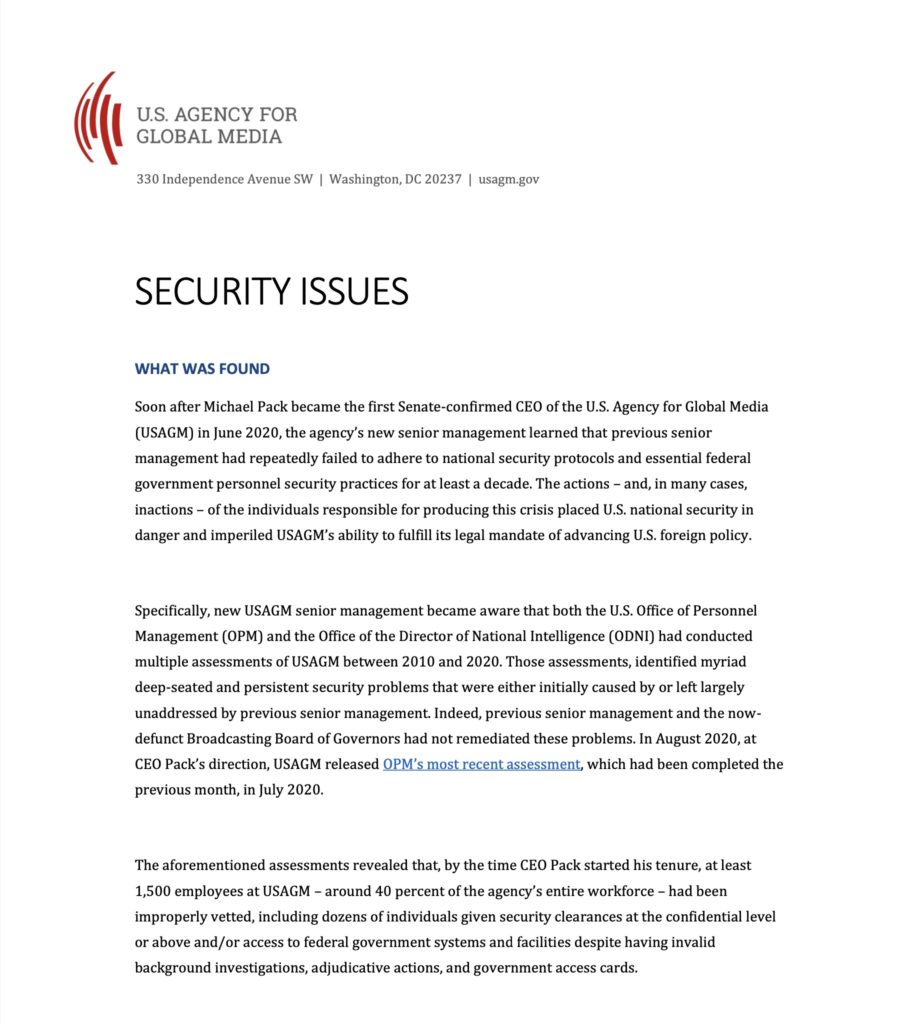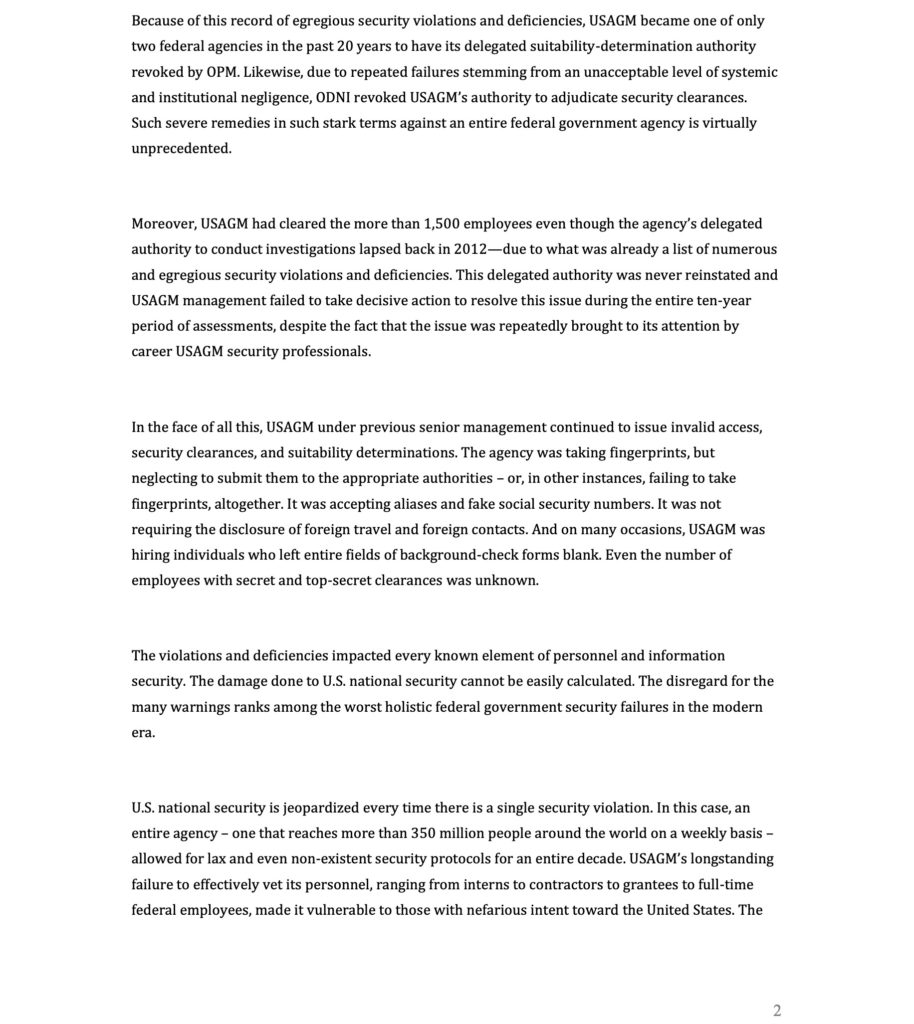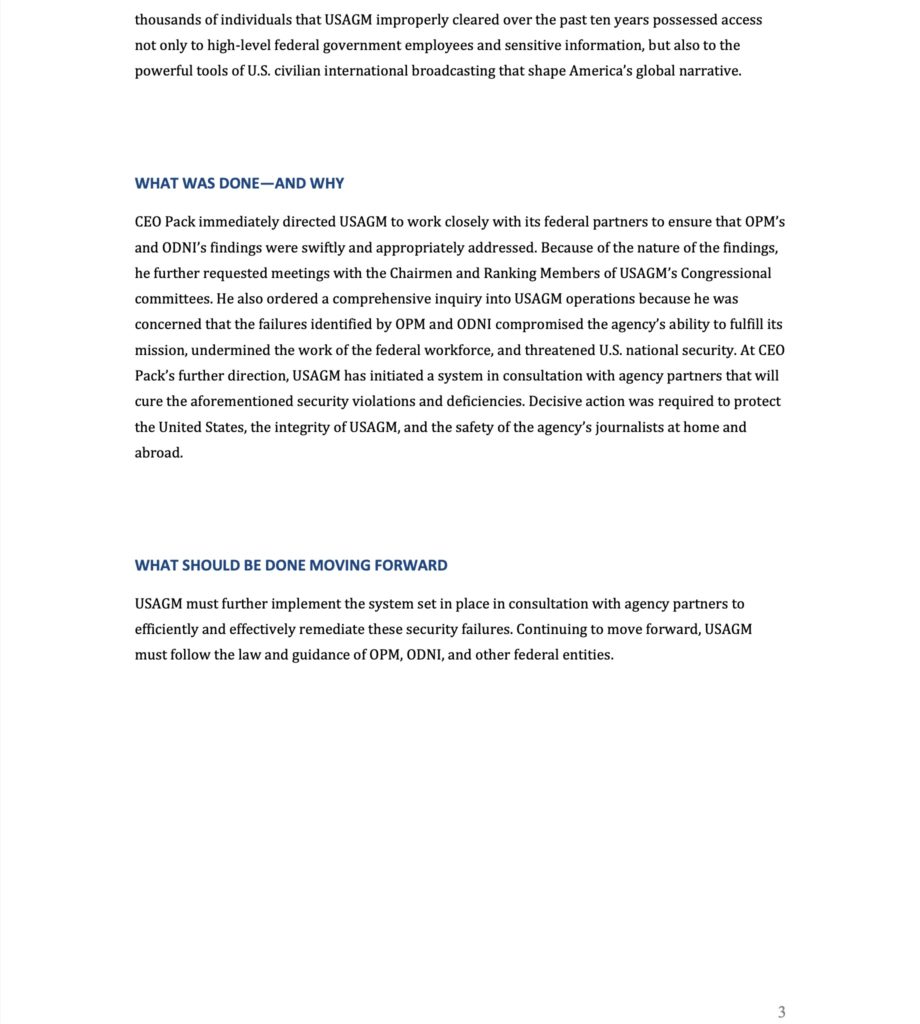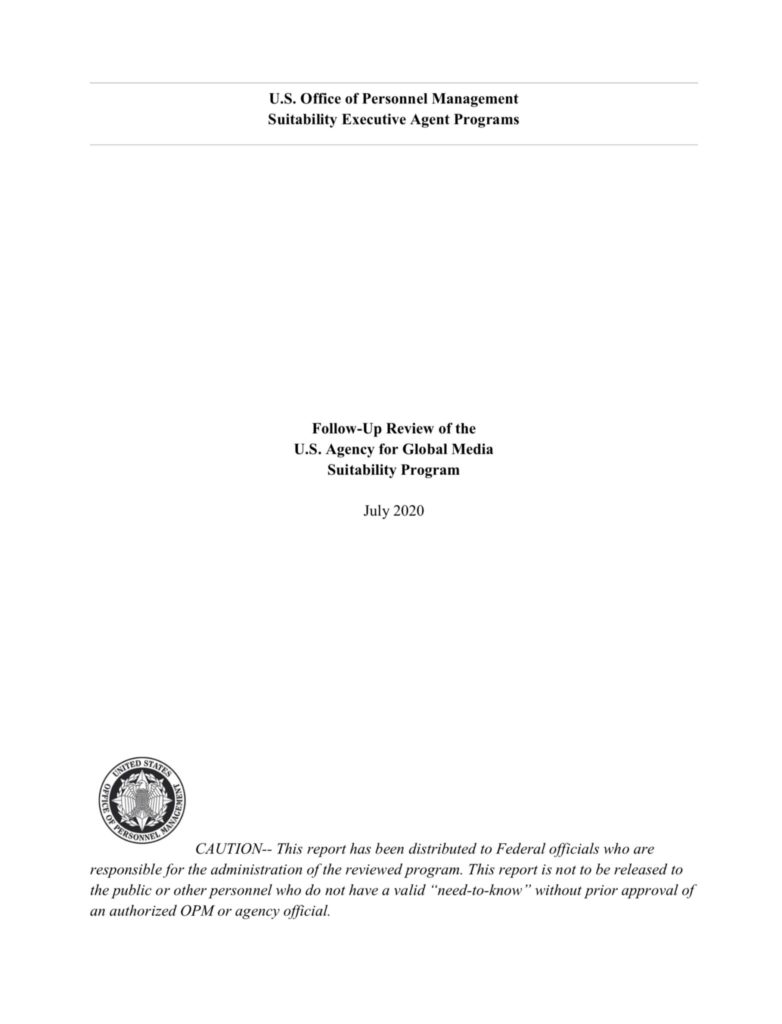USAGM Watch Commentary
Despite being sold to members of the U.S. Congress and U.S. media as one of America’s most effective responses against Russia’s disinformation offensive led by propagandists working for President Vladimir Putin, Facebook and Twitter posts for the Voice of America’s (VOA) fake news busting site Polygraph.Info have shown for years near zero “Likes” and near zero audience engagement on social media.

After it was launched in 2016, Polygraph.Info was touted in a congressional testimony in July 2019 by John Lansing, the then CEO of the $800-million (average annual budget) U.S. Agency for Global Media (USAGM), as a robust and effective fact-checking website capable of countering Russian propaganda and disinformation. USAGM is the federal agency which oversees VOA and other U.S. tax-funded international media operations.
John Lansing’s ambitious claims about Polygraph.Info were echoed to Congress in September 2020 by the then already former Voice of America Director Amanda Bennett who had launched the site a few years earlier after being appointed to the VOA directorship by John Lansing during the Obama Administration. But regardless of what these U.S. government officials had told Congress, Polygraph.Info has had almost zero audience engagement on social media. During more than four years of Polygraph.Info‘s web and social media operations, its posts often still don’t get even a single “Like” or comment on Twitter and Facebook. John Lansing is now the CEO of the National Public Radio (NPR).
According VOA and USAGM press releases and a March 2018 article in Government Executive, Polygraph.Info is managed by Voice of America journalists: “The half-dozen staffers (some are part-time) are all Russian speakers who ‘either came from the region or have reported from Russia or Ukraine’.” Their salaries alone might put the operation’s annual budget at least half a million dollars. Government Executive reported in 2018 that “Some Washington-based staffers requested that they not be photographed.” The government’s business news daily also reported in 2018 that Polygraph.Info was “also adding a reporter with social media expertise, which is important to attracting an audience in Russian-speaking regions.”
USAGM executives continue to claim that Polygraph.Info has been phenomenally successful on social media and gets millions of views. In their their FY2021 Budget Request, they claimed that “Polygraph.info Facebook views more than doubled over the past two years to 7.4 million views in FY 2019,” but the almost total lack of audience engagement and impact on Facebook and Twitter suggests that such views may have been bought with advertising and are in themselves meaningless. Comments on Polygraph.Info Facebook and Twitter pages are practically non-existent.
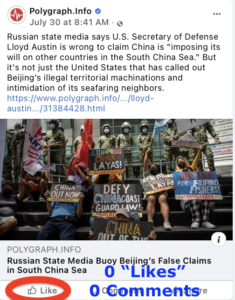
It appears that in 2021 Polygraph.Info experts not only still can’t get even minimal traction on social media in Russia or anywhere else, they also can’t spot questionable reporting about Russia by their own colleagues in the VOA Russian Service. Critics of the management of U.S. international media outreach, including independent Russian journalists fighting against Putin’s propaganda machine, say that some of the careless reporting by the Voice of America is making their efforts to keep free media in Russia alive more difficult.
In June 2021, Galina Timchenko, a Russian journalist and executive editor of Meduza, a Riga, Latvia-based independent online news site, harshly criticized the Russian Service of the Voice of America a few weeks ago for reporting inaccurately that Meduza is closing down due to pressure from the Kremlin. In an interview with Forbes Russia, Timchenko said that the Voice of America “listens to bullsh**.” She added, “you can write that.” Following criticism from Meduza and our own USAGM Watch commentators, the VOA Russian Service first removed and later posted a completely re-written report. In 2012, the VOA Russian Service was deceived into posting a fake interview with Putin critic and anti-corruption leader Alexei Navalny who is now in prison in Russia. VOA posted the fake Navalny interview before Polygraph.Info was started, but the misleading report on Meduza was posted recently and upset a lot of independent Russian journalists.
If Polygraph.Info, which has Russian-speaking journalists, cannot quickly spot and prevent disinformation being spread by VOA’s Russian Service and has practically no one liking its content on social media, this alone should raise alarms among members of Congress of both parties concerned about Russia’s weaponization of information.
Polygraph.Info did not find out or report that under the watch of some of the former and current VOA and USAGM leaders, the Voice of America hired a few journalists who previously had worked for state-controlled media in Russia and Belarus. Some continued to show their former work for Russian state channels on social media after they started working for VOA. One of them prior to being employed by VOA produced Russian-language videos with anti-U.S. and antisemitic conspiracy theories. The journalist’s contract was not renewed, but he was allowed to continue working for VOA until the end of his employment agreement.
Despite no evidence of verified impact of the Polygraph.Info site under the current management and leadership of senior VOA and USAGM executives, they claim to have achieved a great progress in countering Russian propaganda and continue to ask Congress for more money. In its FY2021 Congressional Budget Justification, the USAGM leadership made further claims about the importance of Polygraph.Info‘s on social media.
Providing Fact-based Alternatives to Propaganda
In further support of USAGM Impact Objective 2, in FY 2020, VOA’s Polygraph.info will expand its presence on YouTube and Instagram, as well as add resources to respond to increasing demands for unbiased information among Russian-speakers. VOA’s Polygraph.info will also offer a set of multilingual, interactive tools for use in social media campaigns. Both efforts will improve media literacy among youth and enhance the ability of users and viewers to distinguish facts from disinformation and propaganda.
U.S. Agency for Global Media (USAGM) FY 2021 Congressional Budget Justification, page 25.

Acting VOA Director Tries to Boost Polygraph.Info
The current Voice of America Acting Director Yolanda Lopez, who was previously a key VOA manager working for Amanda Bennett, tried to give a boost earlier this month to VOA’s Polygraph.Info by re-posting on her official VOA Director’s Facebook and Twitter accounts Polygraph‘s August 9 post about Afghanistan and Russia. Her latest effort increased the number Facebook “Likes” for the Polygraph.Info post to three (3).
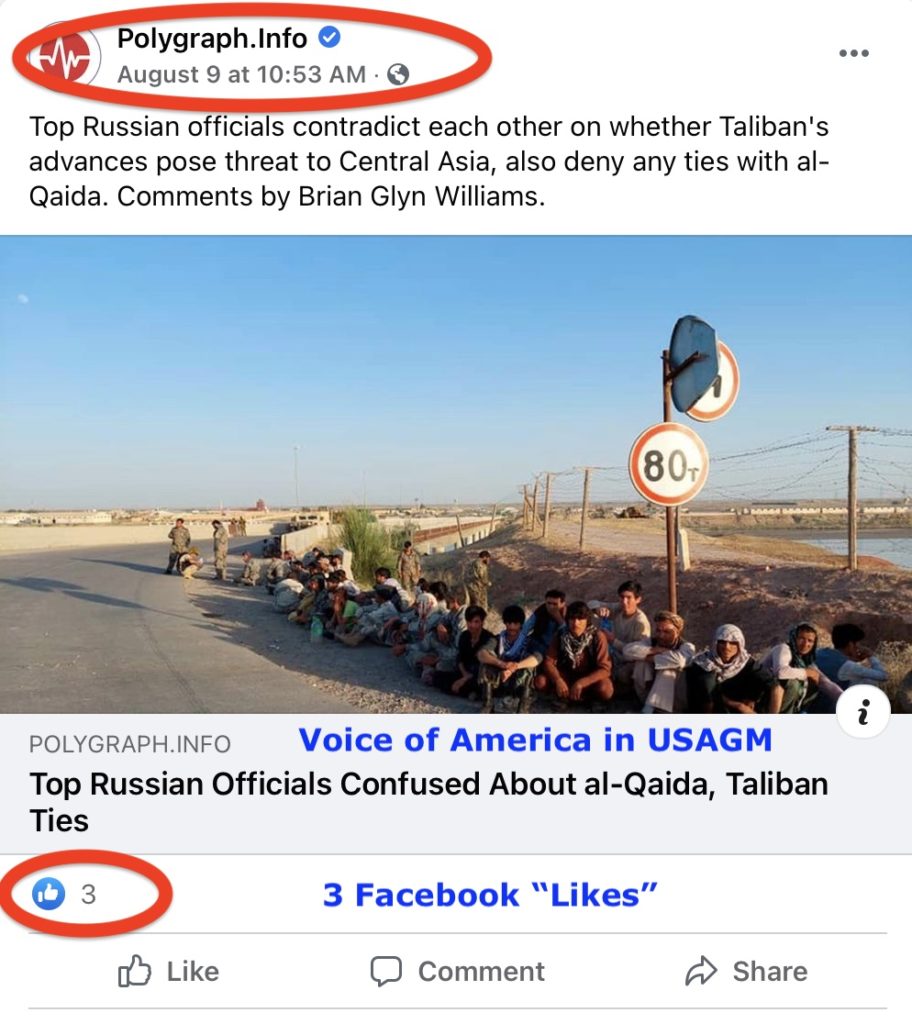
According to a description on the Polygraph.Info site, it employs VOA journalists and effectively counters propaganda and disinformation.
Polygraph.info is a fact-checking website produced by Voice of America (VOA). The website serves as a resource for verifying the increasing volume of disinformation and misinformation being distributed and shared globally.
VOA journalists research and analyze quotes, stories, and reports distributed by government officials, government-sponsored media and other high-profile individuals. The reporters separate fact from fiction, add context, and debunk lies.
Voice of America is a multimedia, nonpartisan, international broadcasters providing accurate news and information, particularly for audiences with limited press freedoms. VOA, headquartered in Washington, D.C., broadcasts in 47 languages to a measured weekly audience of more than 278 million people around the world.
But can this VOA site be effective if practically no one likes or shares its Facebook posts or leaves comments?
Polygraph.Info does not do any better on Twitter.
After four days, its August 9, 2021 tweet about Afghanistan and Russia shows on August 13 only one (1) Like and one (1) Retweet.
Acting VOA Director Yolanda Lopez retweeted the Polygraph.Info tweet. It also made no difference for its popularity or audience engagement.
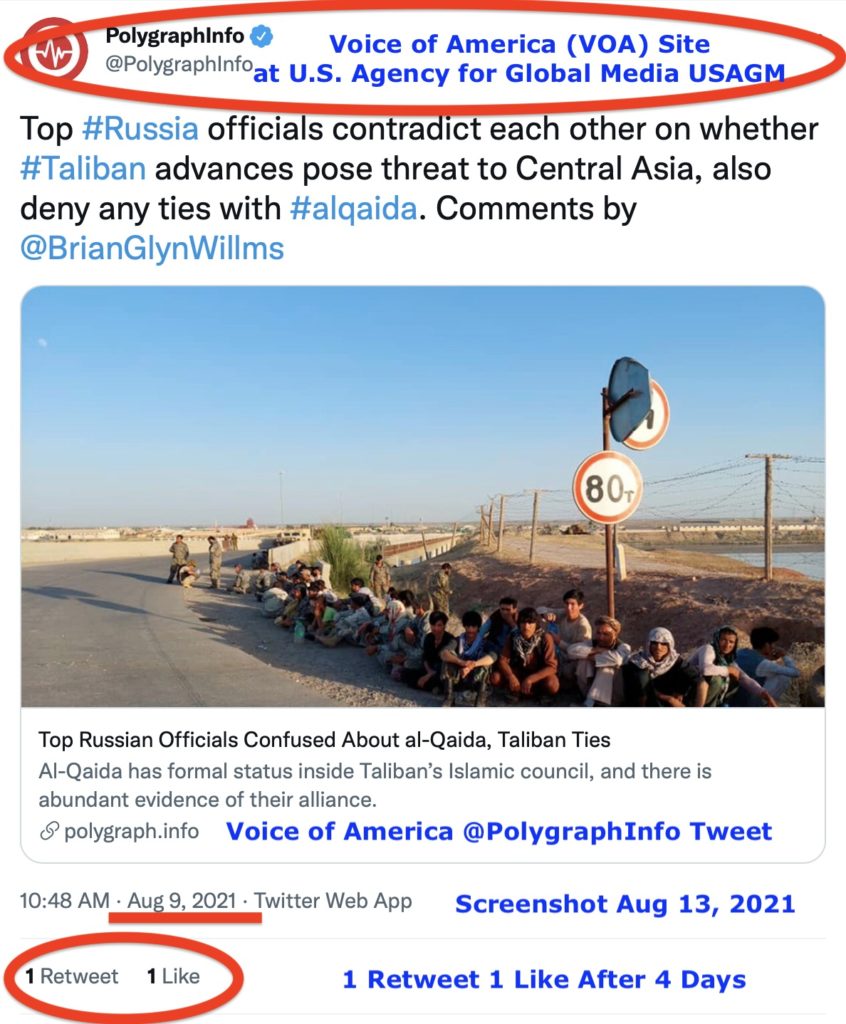
VOA Acting Director Yolanda Lopez’s own Facebook post to boost the Polygraph.Info Afghanistan Post had two (2) “Likes” shortly after it was posted and three (3) “Likes” two days after it was posted.
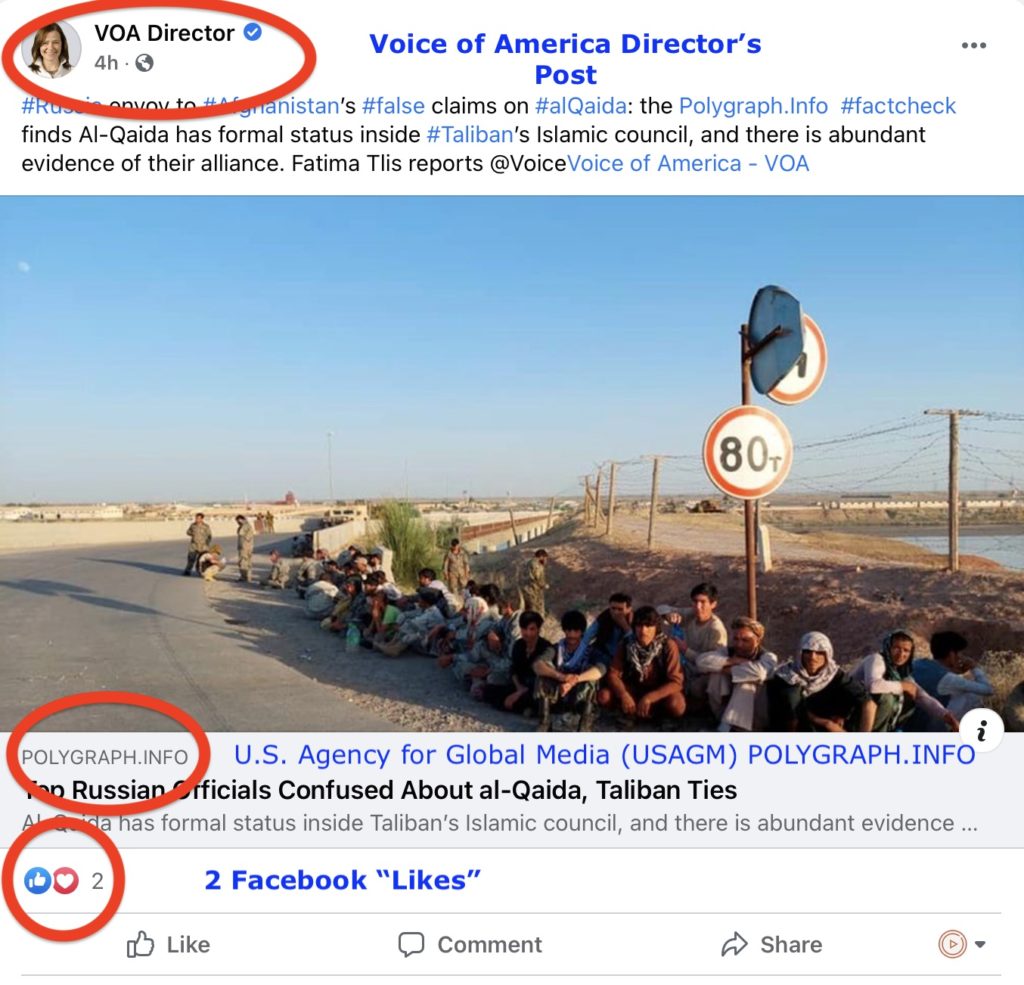
Voice of America’s U.S. and Israel Flag Burning Videos and VOA Animal Videos Are Popular
VOA journalists, who are U.S. government employees and contractors, run the Polygraph.Info site under the overall direction, management and funding of the U.S. Agency for Global Media now headed by Acting CEO Kelu Chao who previously also served in key Voice of America management positions and was one of Amanda Bennett’s principal deputies. For many years, Polygraph.Info Facebook and Twitter posts have shown an embarrassingly low-level of popularity and impact, if such an impact can even be measured with many Polygraph.Info posts getting zero “Likes” and no comments from readers.
However, several Voice of America-produced videos showing burnings of U.S. and Israeli flags posted by the VOA News English newsroom in 2017 under the VOA logo registered thousands of “Likes” and some had over one million views. VOA-produced animal videos also showed many views on Facebook and YouTube. One VOA cat video was originally shot in Russia and had been already shown by Russia’s RT and Sputnik Kremlin channels before being picked up by VOA. We can only say that seeing their work being reused by the Voice of America must have made the Kremlin’s propagandists very happy.
Unlike Polygraph.Info, the Voice of America Russian Service Facebook page gets a considerable number of “Likes” and comments, but it may be a result of paid boost advertising. Just one Russian anti-Kremlin opposition leader Alexei Navalny, even while in prison, gets far more engagement on Facebook than the VOA Russian Service gets from all of its audience. One of his latest posts shows 14,000 “Likes.” But even a single independent Russian political blogger like Rustem Adagamov who goes by the pseudonym of “Drugoi” (“Другой”) gets better traction on Facebook than the entire Voice of America Russian Service costing U.S. taxpayers several million dollars. Members of Congress and their staff would have to ask questions to find out, but it seems clear that Polygraph.Info cannot generate audience engagement on its own. It is also clear that Voice of America-produced videos with anti-U.S. and anti-Israel propaganda got a record number of views on VOA social media platforms.

Amanda Bennett to Congress about Polygraph.Info
The Voice of America public relations site says that “an investigative journalism unit and fact-checking team (Polygraph.info)” were launched during Amanda Bennett’s tenure as the 29th director of the Voice of America (2016-2020). Yolanda Lopez and the current acting USAGM CEO Kelu Chao served under Bennett at the Voice of America in key program management positions during that time and are now in charge of VOA and USAGM. Bennett resigned in June 2020. Chao became USAGM Acting CEO at the start of the Biden Administration and appointed Lopez as Acting VOA Director. Trump-appointed USAM CEO, Michael Pack, served at the agency for only eight months and Robert Reilly, whom he appointed as VOA Director, served less than two months. Pack disclosed what he said were examples of mismanagement and lax security in hiring Voice of America broadcasters by the previous management team and was in turn accused of making false accusations.
Amanda Bennett informed members of the House Foreign Affairs Committee in September 2020 following her resignation as VOA Director that:
Since its inception in 2017, Polygraph.info has grown to become an internationally respected fact-check site and a voice of authority on matters involving Russia and Eastern European countries. Multiple news outlets and fact-checking sites in the region routinely republish Polygraph.info fact- checks or cite them, as have Washington think-tanks and some members of Congress. Currently Polygraph.info is expanding its geographic domain beyond Eastern Europe to audiences in Latin America, Arab countries and China.
House Foreign Affairs Committee, September 22, 2020 Hearing “Oversight of the United States Agency for Global Media and U.S. International Broadcasting Efforts,” Testimony of Amanda Bennett, Former Director of the Voice of America
John Lansing to Congress About Polygraph.Info
John F. Lansing, former Chief Executive Officer and Director of the U.S. Agency for Global Media, testified in front of the U.S. Congress [while he was still USAGM CEO] that the Kremlin’s weaponization of information has led to what he calls “the fight of the 21st century.”
Lansing testified before the U.S. House of Representatives Appropriations Subcommittee on State, Foreign Operations, and Related Agencies for its United States Efforts to Counter Russian Disinformation and Malign Influence hearing on July 10, 2019. This is how Lansing’s testimony was presented in a USAGM press release:
“Make no mistake,” said Lansing, in prepared remarks, “We are living through a global explosion of disinformation, state propaganda, and lies generated by multiple authoritarian regimes around the world. The weaponization of information we are seeing today is real.”
However, this threat does not remain unchallenged. Lansing laid out for the subcommittee how USAGM offers an alternative to Russian disinformation with accurate, independent news and information. Examples included the 24/7 Russian-language digital and television network, Current Time, and fact-checking websites Polygraph.info in English and Faktograph.info in Russian—all initiatives led by the USAGM networks of the Voice of America (VOA) and Radio Free Europe/Radio Liberty (RFE/RL).
In his written statement, which is posted online, Lansing said:
Disinformation Fact Checking
In addition to the Russian and regional language networks, USAGM continues to operate the fact- checking websites Polygraph (in English) and Factograph (in Russian) that counter Russian disinformation. Established in 2016 and 2017 respectively, these services in VOA and RFE/RL investigate misleading statements and stories from Russian officials and state-sponsored propaganda outlets. Polygraph and Factograph serve as a resource for verifying the increasing volume of disinformation and misinformation distributed globally. They separate fact from fiction, add context, and debunk lies. Polygraph has garnered an 849 percent increase in web article views in the past year, and the site has been quoted by U.S. embassies and consulates, as well as independent news organizations such as the Atlantic Council’s Disinformation Portal and The New York Times.
Statement of John Lansing, CEO and Director, U.S. Agency for Global Media Before the House Appropriations Subcommittee on State, Foreign Operations, and Related Programs “United States Efforts to Counter Russian Disinformation and Malign Influence,” July 10, 2019
Are President Vladimir Putin’s Kremlin propagandists shaking in their boots (or bots, if you prefer) with fear that, with the help from the Voice of America’s and the U.S. Agency for Global Media’s current leadership, VOA’s Polygraph.Info will finally damage Russia’s successful fake news operations?
We leave it to the Biden Administration and the U.S. Congress to decide.
END OF USAGM WATCH COMMENTARY
July 10, 2019
Introduction
Chairwoman Lowey, Ranking Member Rogers, members of the subcommittee, thank you for the opportunity to testify today about the efforts of the U.S. Agency for Global Media (USAGM) to counter Russian state-sponsored propaganda and disinformation. I serve as the Chief Executive Officer and director of USAGM, where I oversee all operational aspects of U.S. international media comprising five networks: the Voice of America (VOA); Radio Free Europe/Radio Liberty (RFE/RL); Radio Free Asia (RFA); the Middle East Broadcasting Networks (MBN), which include Alhurra TV and Radio Sawa; and the Office of Cuba Broadcasting’s (OCB) Radio and TV Marti.
USAGM Overview
The mission of USAGM is to inform, engage, and connect people around the world in support of freedom and democracy. We produce news on all media platforms, and our programs reach 345 million people on a weekly basis in more than 100 countries and in 61 languages.
USAGM provides consistently accurate and compelling journalism that reflects the values of our society: freedom, openness, democracy, and hope. Our guiding principles—enshrined in law— are to provide a reliable, authoritative, and independent source of news that adheres to the strictest standards of journalism.
Our agency utilizes a full suite of research and analytics tools to understand the reach and impact of this vital work. We conduct nationally representative surveys to measure how often overseas audiences consume content and on what platforms. We also measure whether audiences find our information credible and share it with others, and whether it helps them form opinions. In a nationally representative survey of adults in Russia conducted between late April and early June 2018, Gallup found that USAGM content (from Current Time, RFE/RL, and/or VOA) was consumed across all platforms by 7.9 million people each week, or 7.7 percent of the adult population. This is an increase from 5.6 million adults in 2016.
We are very proud that USAGM content is considered trustworthy by over two-thirds of our weekly audience in Russia, a remarkable figure considering the overwhelming deluge of state-sponsored propaganda and state-controlled popular media available in the Russian media space. Seven in ten audience members in Russia reported that Current Time and RFE/RL had increased their understanding of current events; six in ten said the same about VOA. Close to half of our
1
weekly audience said that VOA had increased their understanding of U.S. foreign policy and American society.
What these figures show is that our voice is heard and our objective, balanced information is getting through, increasingly to an online and digitally connected younger audience.
The credibility of our reporting—a reputation earned over decades—is why our broadcasts are so highly valued around the world. It is also why our audience continues to grow worldwide, increasing last year by 24 percent. That credibility forms the foundation of our influence and is one of our greatest strengths in pushing back on false narratives and state-sponsored propaganda. We need that credibility today more than ever as we face pressing and pernicious threats to freedom of expression and a free press from Russia and other authoritarian governments.
Russian Disinformation
And make no mistake, we are living through a global explosion of disinformation, state propaganda, and lies generated by multiple authoritarian regimes around the world. The weaponization of information we are seeing today is real. The Russian government and other authoritarian regimes engage in far-reaching malign influence campaigns across national boundaries and language barriers. The Kremlin’s propaganda and disinformation machine is being unleashed via new platforms and continues to grow in Russia and internationally. Russia seeks to destroy the very idea of an objective, verifiable set of facts as it attempts to influence opinions about the United States and its allies. It is not an understatement to say that this new form of combat on the information battlefield may be the fight of the 21st century.
Government control over Russian media outlets has devastated independent media sources in the country, especially on television, where virtually no alternative information sources are available. Russia’s state and state-controlled media inundate audiences with disinformation about global events and depict the United States as being on an irreversible downward spiral, its institutions failing and global strength on the wane. Disinformation campaigns are coordinated among state- funded TV channels, social media platforms, internet services, and so-called trolls to fulfill the Kremlin’s goal of countering what Moscow regards as “Western influence.” Media laws as well as self-censorship for fear of government retribution contribute to a repressive media environment.
Increasingly, Kremlin disinformation campaigns are aimed not only at its own citizens, but also at global audiences. State-sponsored Russian broadcasters such as RT (formerly Russia Today) and Sputnik are expanding their global operations even into the United States. Right here in Washington D.C., Sputnik purchased airtime on a local radio station in 2017 to broadcast Russian state propaganda. Russian state-sponsored disinformation networks operate in English, Arabic, Spanish, French, German, and in at least 25 other languages. Russian influence is contributing to the deteriorating media environments and democratic backsliding in places such as the Balkans, where Russia partners with local media outlets, bloggers, and other influencers to push anti- Western narratives and pro-Kremlin stories.
At USAGM, we have tracked cyber-attacks in recent years on operations in and around Russia, including on the VOA Uzbek Service and on our broadcasts to Russian-occupied Crimea. We are
2
facing challenges on other fronts as well, as the Russian government directly targets USAGM with legal actions. In late 2017, the Russian Justice Ministry declared RFE/RL, VOA, and several affiliated news services “foreign agents” within the Russian Federation. That status had led to bans on reporting by these news services at the Russian State Duma, unwarranted fines resulting from ambiguous regulations, and increased harassment of RFE/RL stringers and freelancers engaged in professional journalism in many regions across Russia. This, and continued legislative efforts by Russia to criminalize dissent, have created security concerns for journalists who work with RFE/RL and VOA within the country. Russia recently passed laws banning so-called “fake news” that enables the authorities to block websites and hand out punishments for material deemed insulting to the state or the public.
The Russian government has targeted USAGM journalists, subjecting them to physical assault, imprisonment, court convictions, arbitrary detention, interrogation, stalking, verbal assault, online threats, and seizure of equipment. It has also targeted the journalists’ family members. Among the most serious cases, RFE/RL contributor Mykola Semena is serving a 2.5-year suspended sentence following a conviction on “separatism” charges in Russian-occupied Crimea, and is barred from working as a journalist for two years. He was convicted based on his written criticism of Russia’s occupation and attempted annexation of Crimea. RFE/RL contributor Stanislav Aseyev was kidnapped by Russian-led forces in a Russia-controlled area of Donetsk, Ukraine in June 2017 and forced to confess falsely to spying for Ukraine.
Make no mistake: the United States is being targeted on the information warfare battlefield, and I do not use that term lightly. It is an uphill battle for us and our democratic allies to counter such a determined and well-resourced foe. In addition to the work of RT, Sputnik, and other Russian media outlets in the region, the Kremlin also targets Russian-speakers with the vast resources of its domestic state-controlled news and entertainment networks. The $28 million a year USAGM can devote to Russian-language programming and the additional $64 million allocated to broadcasting in the rest of Eurasia is a significant investment that shows demonstrable impact— but it is relatively small in comparison.
Nevertheless, USAGM is maximizing our resources and the incredible talent of our journalists to meet this challenge head on by offering audiences an alternative to Russian disinformation in the form of objective, independent and compelling news and information. We are using a multi-pronged approach. First, we are targeting young, entrepreneurial Russian-speaking audiences through direct programming and expanded distribution of our 24/7 Russian-language network Current Time, which is produced by RFE/RL in cooperation with VOA. Second, we have maintained our traditional Russian broadcasts through VOA’s Russian Service and RFE/RL’s Radio Svoboda. These are supplemented with hyper-local digital media through RFE/RL’s North Caucasus and Tatar-Bashkir services in Russia and in regions such as Siberia. Third, USAGM’s Eurasian and Central Asian language services operate in languages such as Ukrainian, Belarusian, Bulgarian, Romanian, Serbian, Uzbek, Kazakh, Azerbaijani, and Georgian, among others, to push back against the Kremlin’s disinformation machine. We are increasingly confronting Russian disinformation efforts in English for a global audiences as well.
Global Russian Programming: Current Time
3
I am excited to share with you the incredible success we are seeing with Current Time. Launched in 2017 with your support, the Current Time television and digital network provides Russian speakers across Russia, Ukraine, Central Asia, the Caucasus, the Baltics, Eastern Europe, and as far away as Israel with access to accurate, topical, and trustworthy information. It serves as a reality check on the disinformation that drives conflict in the region.
The Current Time weekly audience was recently measured at 4.1 percent of Russian adults aged 15 and older (4.2 million people). In 2018, Current Time’s videos received more than 500 million views online and across social media platforms, with more than half coming from inside of Russia. Current Time now has more than two million followers across its social media platforms, including more than 900,000 followers on the network’s primary Facebook page. Current Time’s YouTube channel has more than 600,000 subscribers. These all represent year-on-year double-digit percentage increases, and we anticipate that those figures will continue to climb.
The Current Time television channel is now available in 20 countries via 92 distributers and has more than 50 affiliates—local partner stations that carry individual programs. It has also been able to achieve limited television distribution within Russia, with nine affiliates inside the country. Current Time’s digital arm engages audiences with fresh, compelling content via social media. The service is active on all of the region’s popular social media platforms, including Facebook, VKontakte, Odnoklassniki, Instagram, Telegram, YouTube, and Twitter.
Current Time leverages state-of-the art production value with a robust online presence to capture a younger, social-media savvy, Russian-speaking demographic. It aims to depoliticize Russian- language media by serving as a credible and compelling news source for all Russian speakers, who are often limited to Kremlin-controlled media even when living far beyond Russia’s borders. Current Time places a premium on live news coverage that allows skeptical audiences, numbed by fake news and Kremlin narratives, to judge events on the ground for themselves. For example, Current Time has delivered on-location reporting on topics and events like the Russian presidential elections and opposition protests, the Trump-Putin summit in Helsinki, U.S. elections, major Congressional hearings, the 2018 World Cup, the Skripal poisoning case in England, Russia’s unprovoked attack on Ukrainian naval vessels near the Kerch Strait, Russia’s ongoing aggression in eastern Ukraineconflict, and other major news stories.
Current Time covers social and political protests that state media ignores, and it reports extensively on corruption. Its feature programs have illuminated unknown aspects of life in Russia and beyond, telling the untold stories of ordinary residents in unheralded places whose efforts are improving life for their neighbors and communities. For example, each episode of the Current Time program “Unknown Russia” gives the viewer a look at the lives of ordinary Russians living in unexplored and often neglected corners of the enormous country. Another feature program, “Person on the Map,” focuses on ordinary individuals, such as teachers, farmers, and inventors, who have opted for the provincial life and are eager to build a better world without leaving home.
Current Time’s April 2019 Ukrainian election coverage set a record for the 24/7 Russian-language network with some 9.3 million views across all platforms, and garnered outstanding feedback from partners and audiences alike. The network offered a live broadcast with simultaneous Russian translation of the April 19 debates between the two final Ukrainian presidential candidates to
4
Russian-speaking audiences in countries whose leaders steer clear of public debates with their opponents. Two days later, Current Time broadcast 13 hours of live, non-stop election day coverage of voting by the candidates, Ukrainian citizens, and Ukrainians around the world; exit polls; results; and reactions from the candidates’ campaign headquarters.
Current Time is also giving a voice to opposition figures in Russia. For example, after years of speculation, the anonymous author of the popular Russian social-media account, StalinGulag—an acerbic critic of current affairs in Russia—revealed his identity and sat for an interview with Current Time. The twenty-seven-year-old Aleksandr Gorbunov, whose Twitter account has over 1.1 million followers, decided to go public after his elderly mother’s apartment was searched for spurious reasons. Social media audiences responded robustly, viewing the interview about 300,000 times.
Current Time also offers an array of information on U.S. policy and perspectives produced by the VOA Russian Service in Washington and across the U.S. In the lead-up to the 2020 U.S. elections, Current Time will feature special programming explaining America’s democratic experience while focusing on issues targeted by Russian disinformation. Starting with the first Democratic primary debates in Miami in June, VOA expanded its programming to provide live coverage from across the U.S.
In an indication of the Kremlin’s irritation over Current Time’s coverage, Russian state media has featured it in at least six separate segments since May 2015, decrying it as part of a “U.S. information war” and labeling it a threat to national security.
The Current Time model of collaboration between RFE/RL and VOA has been such a success that USAGM followed this playbook with the launch of a 24/7 Persian network called VOA365, and has plans to expand the concept to Mandarin this year.
VOA Russian Service
VOA’s Russian Service has provided coverage of America’s democratic experience to the Russian-speaking world since 1947. Due to Russian restrictions on broadcasting inside the country, the service currently employs a digital-first, cross-platform strategy to fulfill its mission. The goal is to offer fact-based alternatives to the Kremlin’s disinformation campaigns designed to fan anti-U.S. and anti-Western sentiments both in Russia and globally. VOA Russian’s interactive multimedia content includes video streaming on desktop and mobile platforms, products made for social media, expert blogs, and user-generated content and feedback. It serves to engage audiences in conversations about American life and values while offering insights into U.S. policy and institutions, including U.S.-Russia relations and American reactions to developments influencing Russian domestic politics and governance.
From June 2018 to June 2019, the VOA Russian Service website registered an average of 2 million monthly visits and 2.5 million monthly article views—typically attracting a more educated and liberal Russian-speaking audience. During the same period, videos on VOA Russian’s digital platforms garnered 147 million views on Facebook and 12.7 million views on YouTube. Facebook is the Service’s most active social media outreach platform, receiving about 1 million post
5
engagements daily. Original content includes live reporting by VOA correspondents and immersive formats such at 360 panoramic videos.
The VOA Russian Service programs aim to tell America’s story. Specific new programming includes “America Live Coverage Desk” – VOA’s live, unfiltered coverage of events in America. Launched in 2017, “America Live Coverage Desk” features real-time analysis by U.S.-based experts and simultaneously translated presidential addresses, major policy pronouncements, speeches, debates and congressional hearings. This past year the service launched the “Great American Road Trip”, a 20-episode travel TV program where VOA Russian journalists take viewers beyond major tourist routes and destinations and introduce them to people who represent the American character – self-made problem-solvers, innovators, thinkers, and role models.
The VOA Russian Service also produces a variety of programing, now over 11 hours a week, which all air on the Current Time TV channel. “Current Time America,” a one-hour, Monday-to- Friday television newscast, offers content not otherwise available on state-controlled Russian media and a “reality check” on various political, economic, social, and cultural issues. It features live interviews with newsmakers and the latest in business, science and technology, medical, and entertainment news. A stringer network across the United States provides news and feature programming from major American cities. Other new content includes live, unfiltered, simultaneously translated coverage of major events in America; new weekend talk shows; and documentary programming.
In addition to the unique role that VOA has in showcasing the American experience to foreign audiences, the VOA Russian Service also shines a light and gives a voice to opposition figures in Russia. A recent interview with exiled former oligarch and regime critic Mikhail Khodorkovsky garnered more than 1 million views on YouTube, and was picked up and reposted by numerous Russian outlets. In June 2019, VOA Russian digital team members covered the mass protests resulting from the detention of Russian investigative reporter Ivan Golunov, who was detained in Moscow on bogus drug charges. The team successfully obtained commentary from influential participants. In addition to the live coverage of the protests as they unfolded, including hundreds of detentions, the digital team produced a video explainer with human rights statistics, reminding the audience of Russia’s press freedom challenges.
RFE/RL’s Radio Svoboda
RFE/RL’s mission is distinct from VOA’s, in that its purpose is to serve as an example of what a local and independent media can and should be. Thus, the focus of its programming is often reporting on local news that is not covered by Russia’s domestic media. RFE/RL serves as a “surrogate” for free press in Russia and in other countries in the Russian periphery. Its flagship Russian Service, known locally as Radio Svoboda, live streams from important public events, such as protests, and provides a wealth of Russia-focused content online, on social media, and by radio.
Radio Svoboda maintains a bureau in Moscow with approximately 50 staff, and utilizes other freelancers throughout Russia and around the world who are under significant pressure for their work.
6
Radio Svoboda programming provides analysis on Russian current affairs, politics, social issues, human rights, and culture in and where they live, in addition to investigative pieces not covered by domestic Russian media. The media mix ranges from news, to documentary programming, to other Russian-language shows designed to compete with the disinformation exported by the Kremlin. Radio Svoboda also features eight daily news bulletins, live streaming from important public events such as protests, and video/TV casts of talk shows and programs.
As an example of the impact that Radio Svoboda makes, the network recently drew an audience of over 2 million to its reporting on the May Day protest detentions. More than 100 people were detained during opposition rallies across Russia, led by Alexei Navalny, a vocal critic of the Kremlin and a leading opposition figure. The Russian police responded with force to shut these events down. Current Time aired TV footage from St. Petersburg that showed police hitting people with batons and dragging them to police vans; the video attracted some 900,000 online views. Total views for the May Day coverage across all platforms came to more than 1.2 million.
Programming in Languages other than Russian
In addition to reaching Russian-speaking audiences, USAGM broadcasts continue to push back against Kremlin propaganda in other languages used in the Russian Federation, as well as in Central Asia and the Balkans. Original content is generated at many levels – local, national, and regional – and then translated across language services to provide audiences with a diverse news menu. A central goal of each of these, in addition to providing local and national news coverage in local languages other than Russian, is to push back against the false narratives coming out of Russia.
For example, the VOA Georgian Service devotes 70 percent of its overall programming to countering Russia’s disinformation and anti-Western propaganda inside Georgia. The VOA Serbian Service has significantly expanded its programming in recent years with the aim of countering growing penetration of Russia-sponsored media and disinformation into the Serbian and Montenegrin media space. VOA Serbian has expanded its coverage regarding the Russian presence and influence in many areas of politics, society, culture, and economics, including the growing influence of Russian soft power through civil society organizations, cultural exchanges, and ties with the Eastern Orthodox Church.
On June 5th, 2019, RFE/RL conducted a live interview with new Ukrainian President Volodymyr Zelenskyy in which he reaffirmed that Ukraine is on a “course toward Europe.” In May, the TV channel “Ukraina” aired the Ukrainian Service documentary “Balukh” on the Ukrainian activist sentenced in Russian-occupied Crimea for flying a Ukrainian flag. RFE/RL correspondent Anzhelika Rudenko, who travelled to Crimea in 2018 to document reaction to his arrest by Balukh’s neighbors in the village where he lived, was subsequently banned from returning to Crimea by Russian occupation forces. According to the channel, the documentary, which aired at midnight, reached 740,000 people – second only to a political talk show on the 1+1 channel popular with viewers age 18 and older.
In Kazakhstan, RFE/RL’s Kazakh Service and Current Time both had extensive live coverage of the June 9, 2019, presidential election, which was widely seen as an orchestrated handover of power from the longtime president and Russian ally Nursultan Nazarbaev to a hand-picked
7
successor. USAGM broadcasts documented the ensuing protests in Nur-Sultan and Almaty and the detention of nearly 4,000 people including several journalists. Meanwhile, the Kazakh state- run media misrepresented or ignored these developments. RFE/RL’s continuous reporting from Kazakhstan received a robust audience response, with more than 1.6 million views of the Kazakh Service’s live election and protest coverage, and another 816,000 views of an interview with the only opposition candidate in the election, Amirzhan Qosanov.
On an even more localized level, RFE/RL covers news in the Tatar, Bashkir, and Chechen languages, providing relevant news coverage to Russia’s underserved and marginalized populations in politically sensitive areas. RFE/RL has also launched hyper-local websites to focus on the realities on the ground in Russia-occupied Crimea, Donbas, the mid-Volga region, the North Caucasus, and Siberia.
Disinformation Fact Checking
In addition to the Russian and regional language networks, USAGM continues to operate the fact- checking websites Polygraph (in English) and Factograph (in Russian) that counter Russian disinformation. Established in 2016 and 2017 respectively, these services in VOA and RFE/RL investigate misleading statements and stories from Russian officials and state-sponsored propaganda outlets. Polygraph and Factograph serve as a resource for verifying the increasing volume of disinformation and misinformation distributed globally. They separate fact from fiction, add context, and debunk lies. Polygraph has garnered an 849 percent increase in web article views in the past year, and the site has been quoted by U.S. embassies and consulates, as well as independent news organizations such as the Atlantic Council’s Disinformation Portal and The New York Times.
Looking Ahead
Looking to the future, USAGM will continue to prioritize Russian-language broadcasting to combat the Kremlin’s sustained dissemination of disinformation and state-sponsored propaganda. We have bolstered our reporting capabilities throughout Russia, Ukraine, and neighboring countries during the past year and will continue to do so. In addition to our Russian-language efforts, we will continue to develop news capabilities in other languages used in the Russian Federation, Central Asia, and the Balkans, build live news capabilities, expand acquired and commissioned programming, and meet digital audiences on their preferred platforms. USAGM will continue to seek Current Time placement opportunities and expand our reach in underserved markets.
We cannot do this without the support of the Congress. Chairwoman Lowey, Ranking Member Rogers, we are deeply grateful for your support of our work and we value your oversight role. Thank you for the opportunity to testify today, and I look forward to any questions you may have.
8
House Foreign Affairs Committee
September 22, 2020 Hearing
“Oversight of the United States Agency for Global Media and U.S. International Broadcasting Efforts”
Testimony of Amanda Bennett Former Director of the Voice of America
Chairman Engel, Ranking Member McCaul, and members of the committee. Thank you for allowing me to testify today.
My name is Amanda Bennett. I am the former director of the Voice of America (VOA). My journalism career spans nearly 50 years, all but the previous four in private industry. I was a reporter at the Wall Street Journal for 23 years. I was their second Beijing correspondent. I held senior positions, including top editor, at four other leading U.S. news organizations. I am also a two-time Pulitzer prize recipient and served for nearly a decade on the board that awards those prizes.
I am here today to testify about the media organizations I have grown to love and respect: VOA, Radio Free Europe/Radio Free Liberty, Radio Free Asia, the Office of Cuba Broadcasting, Middle East Broadcast Networks and the Open Technology Fund. All are now overseen or funded by the U.S. Agency for Global Media (USAGM).
Of course, I know best the work of VOA – its dedicated, selfless and courageous staff – where I proudly served as the 29th Director from 2016 until June 2020. But all operate under the same ethics and standards. By law and custom they practice what the law enshrining the Firewall protecting journalists and editors from outside interference calls “the highest standards of professional journalism.”
VOA and its fellow organizations are different. They combat global misinformation, propaganda and false narratives by using America’s own strengths, particularly its free press. The very ability to use a free and independent press to report and explain America tells the world more than words and images alone could do. The value of independent journalism is far better than messaging and great journalism is great public diplomacy. VOA exports to the world the First Amendment, guaranteeing free speech. In our polarized political and media environment, VOA reporters and editors work every day to claim the broad middle ground, exactly as VOA’s Charter – signed by President Ford – envisions.
We Are Journalists
VOA is America’s largest international broadcaster, 100% government-funded but by law operationally independent. Now over 75 years old, VOA distributes news and information by radio, television and digital in 47 languages across the globe. Through Radio, television, mobile and the Internet it reaches over 280 million people weekly. In many of the countries it reaches, VOA is the only source of credible news.
Journalism is at the heart of the USAGM mission, “to inform, connect and engage people around the world in support of freedom and democracy,” and the missions of VOA and the other networks. It has been and is embedded throughout their Charters. Other US information organizations, like the State Department’s Global Engagement Center, carry out the business of messaging to directly influence foreign public opinion.
We Depend on the Statutory Firewall
The single most important factor in our effectiveness is the separation between our newsrooms and policy makers and political influencers. We call this separation the Firewall. By law and regulation, any Executive branch employee outside the newsroom unlawfully breaches the Firewall when the employee “attempts to direct, pressure, coerce, threaten, interfere with, or otherwise impermissibly influence any of the USAGM networks, including their leadership, officers, employees, or staff, in the performance of their journalistic and broadcasting duties and activities.” The fact that news is provided outside of the control of the political party in power gives VOA its power. Audiences around the world see and appreciate the credible information VOA provides. We know from the world markets VOA surveys that it enjoys 60 to 80 percent credibility ratings — even in countries like Iran considered hostile to America.
During my service as Director, I depended on the protection of the Firewall to refocus VOA’s mission to be the free press to the world. We covered all – not just some – Americans. We increased coverage of news stories originating across the nation. Much of the world is interested about all of America. VOA reported proudly on all the things that America excels at — technology, entrepreneurship, medical advances and research, education, and philanthropy while at the same time reporting, unflinchingly, on unpleasant news like school shootings and racial tension.
We Succeeded
On my watch, we held ourselves to the highest standards. Combating bias in journalism is a critical task, especially in today’s polarized environment. VOA made bias training mandatory and through regular communication made eliminating bias a priority. VOA was tough on ethics violations, on internal corruption and on inappropriate use of social media. VOA leaders were transparent and forthcoming in these matters – outsiders knew of these actions immediately because VOA disclosed them immediately.
Moreover, VOA extended its original mission of bringing news and information to those most isolated by launching broadcasting into refugee camps, and dramatically increased focus on women in the world. The team moved VOA decisively into the digital space, where its audiences’ attention was rapidly moving.
2
The objective results we achieved attest to what can be accomplished. Attached as an Exhibit is a May 2020 summary and employee survey documenting the successes achieved over the past four years. There are many. For instance, Morale, for which the agency had been rightfully criticized, rose steadily during those four years with overall satisfaction jumping from 47% in 2016 to over 70% in 2020.
Morale improved because people took their mission seriously and wanted only to have obstacles to achieving their mission removed or minimized. This was not just a feel-good exercise: it is proof of the power of the mission. Morale improves when you treat people with respect, support a mission with a high and inspirational purpose, set high ethical standards and enforce them rigorously but fairly. People want the organization to perform the way it is intended to perform and accomplish the mission it is tasked with accomplishing.
The fundamental factor in all this is the Firewall. A news organization tethered to the manners and mores of a political party will inevitably become what VOA has striven for decades to avoid: A propaganda machine, indistinguishable from those of the authoritarian regimes we cover.
I ask anyone who hears or reads this statement to do everything in his or her power to strengthen this Firewall. We must ensure that it is applied in reality and not just in words.
Thank you.
Memorandum Issued by USAGM CEO Michael Pack


